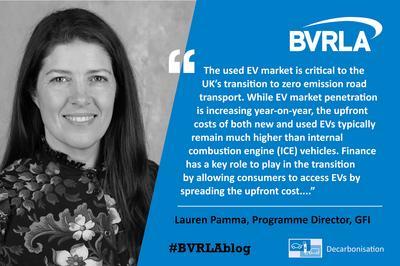Lauren Pamma, Programme Director at the Green Finance Institute (GFI) looks at overcoming the barriers to EV adoption particularly in the critical used market.

The used EV market is critical to the UK’s transition to zero emission road transport. While EV market penetration is increasing year-on-year, the upfront costs of both new and used EVs typically remain much higher than internal combustion engine (ICE) vehicles. Finance has a key role to play in the transition by allowing consumers to access EVs by spreading the upfront cost through monthly payments.
New research we’ve undertaken at the Green Finance Institute on behalf of the Office for Zero Emission Vehicles (OZEV) found the availability of data for EVs has improved, with many lenders and lessors providing finance options for EVs in line with those offered for ICE vehicles.
As part of research for OZEV, we surveyed 2,000 consumers, 20 motor finance lenders and four lease companies, and engaged with over 20 dealerships, to understand what the barriers to used EV adoption are, and if finance is one of these barriers.
Prior to embarking on this work, anecdotal feedback suggested lenders historically set lower Guaranteed Future Value (GFV) percentages for EVs relative to ICE vehicles due to a lack of data and higher volatility of used car values. This risked negatively impacting EV adoption by increasing the total amount a customer pays for finance, reducing competitiveness of finance deals compared with ICE vehicles and further compounding the challenges caused by the EV price premium.
The lender survey, supported by stakeholder interviews, did not identify significant variations in the parameters set by lenders for EVs and ICE vehicles. Growth of the EV market over the last few years has increased the volume of data points available to support RV forecasting, and volatility has decreased. As a result, most lenders have now aligned their GFV policies across the different fuel types. Though outliers remain, as the market continues to mature it is expected that they will update their policies.
More generally, the survey also found that EV buyers are being offered the same selection of financial products on comparable pricing and terms. Only two of the twenty lenders surveyed still do not offer funding for EVs. Of those that do offer finance for EVs, 80% offered the same product selection for EVs as ICE, both used and new. Across the whole survey, only one lender reported offering products for new EVs but not for used EVs, which shows encouraging progress.
The findings of the consumer survey demonstrate strong demand for EVs amongst consumers, and like the lender survey, suggest that finance is not a barrier to used EV adoption. The main barriers to switching include concerns around battery health, reliability, cost, and charging infrastructure. These can be addressed through sharing of data with both consumers and dealerships, the latter being identified in the survey as playing a key role in informing consumers. There is an opportunity for finance providers to support consumers switching by helping to reduce friction at point of sale, particularly when it comes to the cost and process of installing and using charging infrastructure.
In conclusion, most lenders and lease companies are offering accessible and affordable finance for all types of EVs – used and new. Where appropriate, finance companies have a role to play in accelerating and enabling the transition by educating consumers and dealerships to help overcome challenges around battery health, charging infrastructure, and affordability, and innovating ways to finance new technologies by improving the customer experience.
For more information about the research and ongoing work, contact Lauren Pamma at the Green Finance Institute.





